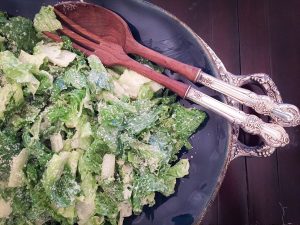Healthy Caesar Salad Recipe
Reproducing a dish from a recipe is easy, right? I mean, it’s pretty straightforward. You follow instructions, with quantities and everything, and you should end up with what’s on the picture.
But that’s not always the case. I remember when I was teaching culinary students, I would give the same recipe to 5 different groups, and end up with 5 completely different results!
How can this be?
You see, cooking is not an exact science. There are so many factors influencing the final result. Following directions being one of them.
 And then there are dishes, like Caesar salad for instance, that are just not prepared the same way twice. Have you noticed that? Go to any 2 restaurants in America, order a Caesar salad, and you can be assured it will be very different from one restaurant to the other.
And then there are dishes, like Caesar salad for instance, that are just not prepared the same way twice. Have you noticed that? Go to any 2 restaurants in America, order a Caesar salad, and you can be assured it will be very different from one restaurant to the other.
Caesar salad is ubiquitous. You can’t escape it. It’s on most restaurant menus in America. So many different recipes. Some use raw eggs, others just an olive oil, parmesan, and garlic dressing, some add tomatoes, some add grilled chicken or grilled salmon, and even the size of the croutons is a point of contention.
All this fuss for the most famous salad in America, which was likely born in Mexico anyway!
A simple, properly made Caesar salad is a beautiful thing: Crisp Romaine lettuce lightly tossed in flavorful extra-virgin olive oil and real Parmigiano-Reggiano, a touch of garlic, a drizzle of lemon juice, some rustic, homemade croutons.
And then there are the anchovies. Ah, the anchovies!.. I’d like to tell you (force you, even?) to give them another try, but I know that for most people, trying to convince them to eat anchovies is just a lost cause.
I’ll try one more time: maybe start with a tiny bit of anchovy paste in the dressing, or even better, start with fresh, unsalted anchovies. Available in Italian or Spanish food stores, or some fancy supermarkets like Whole Foods.
Fresh anchovies are way less pungent and obviously less salty than the regular canned anchovies you’d find in a supermarket.
I’ll stop harassing you with my anchovies. My real point remains with the Caesar salad: There are as many recipes as there are cooks in America.
Most of them, alas, are either fat bombs that will make you gain a lot of weight, and/or contain raw eggs, which is not really recommended given the state of the egg industry (It’s nasty!).
With that in mind, I want to bring your expert attention toward my Caesar Salad recipe on page 63 of Eat More, Burn More. That recipe is fast (5 minutes!) and uses only wholesome, delicious ingredients that are fat-burning. That’s the best of both worlds.
It’s also designed so that you can create and build your very own Caesar salad. Sure, Caesar salad is classic. But don’t let that control your creativity. There are interesting options available. For instance, replacing Romaine with kale or other super greens.
Feel free to add ingredients too. Try cherry tomatoes, cooked green beans or asparagus, or even leftover Brussels sprouts — especially if they’re cooked right like I advise on page 201 of Eat More, Burn More.
I like to use plain Greek yogurt for dressings. It’s tangy, healthy, and contains probiotics (which means it helps your gut micro-organisms). And that’s what gives my dressing perfect consistency. I like to emulsify it in a blender for a great texture.
For even better fat-burning benefits, I replace the traditional croutons (always an issue if you’re trying to lose weight) with real whole-grain, unsweetened cereals to give a similar crunch to the salad. Companies like Ezekiel’s or Bob’s Red Mill offer great, wholesome cereals that make a huge difference and help you reach your goals. (Click Here to Check out Ezekiel Cereals)
Finally, I strongly advise you to pay attention to Parmesan. Or “Parmigiano-Reggiano” rather, as there is only one worthy of the name. And as I always say, let’s ban pre-shredded cheese and grate our own blocks of cheese. That too makes a difference with flavor and wholesomeness.
Please avoid “fillers” like the plague. Last February, Walmart and Kraft were sued over “Parmesan” cheese with wood pulp filler (Cellulose). Which is, believe it or not, a common filler (approved by the FDA!) in the food industry.
Salads in general, are a great way to help you with your diet. And Caesar salad can be a part of that diet, provided you make it wisely.
To your great success,
![]()


